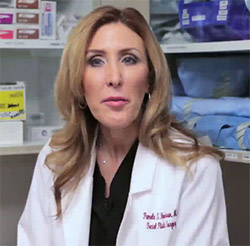How is Plasmage different from laser skin resurfacing?
Scottsdale Plasmage and laser
Dr. Henderson is always watching the research, so she can offer the most effective new treatment options to her patients. Recently, she started offering treatments with Plasmage. This is the first FDA-approved fractional plasma device, and it can be used for a number of different skin concerns.
Some of our patients ask how a fractional plasma treatment is different from laser skin resurfacing. Although both of these types of treatment apply energy to the surface of the skin, they do so in different ways, and with different results.
What are the differences between Plasmage and a laser treatment?
Type of energy used
Plasmage and laser skin resurfacing apply different types of energy to the skin.
The Plasmage handpiece ionizes particles in the air in order to generate plasma, which is the highest-energy form of matter. As the plasma energy contacts the surface of the skin, it heats it extremely rapidly. This causes the skin’s outer surface to undergo a process called sublimation, which essentially means that it’s vaporized. However, this only occurs right at the surface.
By contrast, a laser skin resurfacing treatment uses laser energy, which is a high-energy form of light. This also causes heating when it contacts the skin, and may lead to sublimation of the outer layer. In addition, the laser energy can penetrate down into the deeper layers of the skin, causing localized heating of these areas.
While laser energy can be applied across the entire surface of the skin, it’s more common to have a fractional laser treatment. This involves applying laser energy in small discrete “dots” across the area to be treated. At each treated zone, the laser energy will trigger the skin’s healing response. The untreated areas act as a reservoir of cells to help the treated zones heal.
Depth of treatment
Although the plasma energy generated by Plasmage is very high-energy, it also doesn’t penetrate very deeply into the skin. It causes very rapid heating of the outer surface of the skin, but doesn’t really go any deeper than that.
This means that Plasmage is best suited for treating issues with the surface layer of the skin. This includes fine lines, dark spots, stretch marks, and even warts. Because Plasmage is a relatively gentle treatment, it’s safe for use on delicate areas like around the eyes, and can be used to treat droopy upper eyelids. However, because it doesn’t penetrate into the deeper layers of the skin, Plasma isn’t really suited to treating issues with those layers.
By contrast, laser energy is able to penetrate into the skin. This allows it to impact the dermis, which is the connective tissue layer of the skin. Localized heating of the dermis triggers the production of collagen and elastin in this layer. These structural proteins provide a tightening and rejuvenating effect.
Like Plasmage, laser skin resurfacing can address surface issues, such as fine lines, dark spots on the skin, and stretch marks. Laser treatment can also be used for deeper wrinkles, scarring (including acne scars), and issues like uneven skin texture or pigmentation. Depending on the specific laser and the energy it’s used at, the depth of the treatment can be controlled, to tailor the treatment to the patient’s specific concern.
Recovery period
For both treatments, the recovery period can vary somewhat. These treatments are customized to each patient’s needs. Some treatment sessions are more extensive or involve larger areas than others, which can affect the recovery time. In addition, different people’s bodies heal differently.
In general, however, the recovery period from Plasmage is a bit quicker than from a laser treatment. This is particularly true for laser treatments that target deeper layers of the skin, which tend to take a bit longer to heal.
With Plasmage, the area will be somewhat red at first. Soon, small crusts will form over the treated area. These fall off in about a week. Continued healing occurs for about 12 weeks following the treatment, and the results gradually improve over this time.
With a laser treatment, there’s also initial redness and swelling. Crusts may also form over the treated area. About a week after the treatment, the skin may begin to peel. Peeling doesn’t always occur – whether or not this happens depends on the specific laser treatment. After two to three weeks, the peeling and crusting should have healed. Continued healing also occurs with laser, and can continue for six months to a year, with results improving gradually over this period of time.
Scottsdale Plasmage and laser
Overall, Plasmage is a less invasive option with a gentler recovery. Laser skin resurfacing is a bit more extensive and requires a longer time commitment for recovery, although it can achieve more dramatic results. Different treatment options will be best for different specific concerns.
 A consultation with Dr. Henderson will allow her to learn more about your situation and do a physical exam. She can then let you know whether she recommends Plasmage, laser skin resurfacing, or a different treatment option. Please contact our front desk to schedule your appointment.
A consultation with Dr. Henderson will allow her to learn more about your situation and do a physical exam. She can then let you know whether she recommends Plasmage, laser skin resurfacing, or a different treatment option. Please contact our front desk to schedule your appointment.

